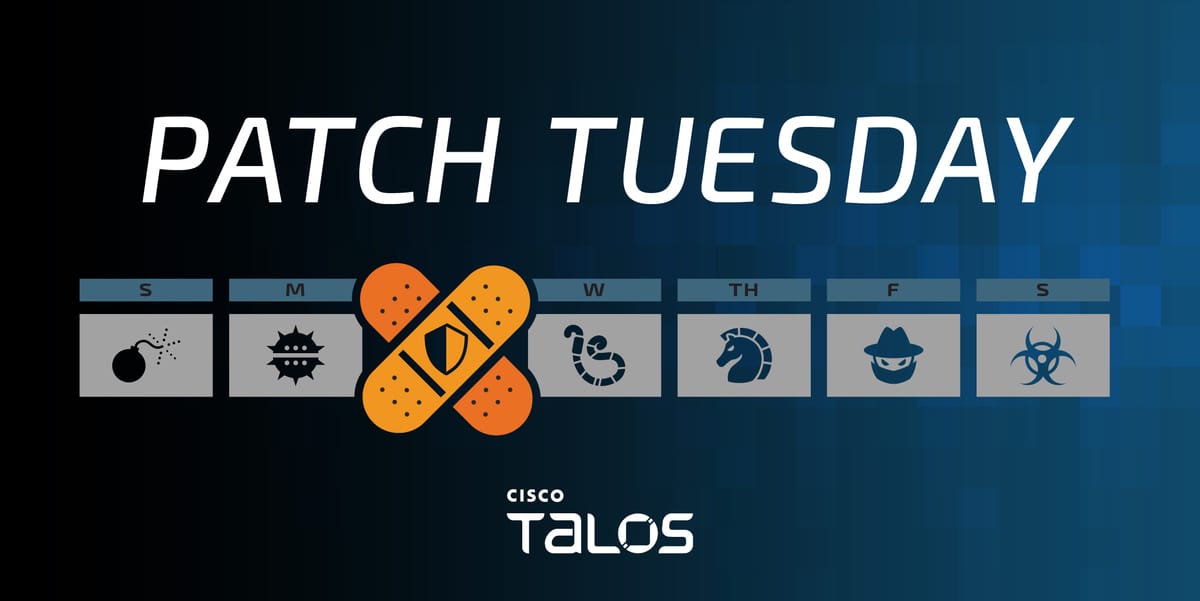Microsoft Patch Tuesday for January 2025 — Snort rules and prominent vulnerabilities

Microsoft has released its monthly security update for January of 2025 which includes 159 vulnerabilities, including 12 that Microsoft marked as “critical.” The remaining vulnerabilities listed are classified as “important.”
One notable critically rated vulnerability that has been patched this month is CVE-2025-21309, which is a remote code execution vulnerability affecting Windows Remote Desktop Services. Exploitation of this vulnerability could lead to arbitrary code execution on systems where the Remote Desktop Gateway role has been enabled. This vulnerability has been assigned a CVSS 3.1 score of 8.1 and is considered “more likely to be exploited” by Microsoft.
Another notable remote code execution vulnerability in Window Object Linking and Embedding (OLE) was also patched this month. This vulnerability, CVE-2025-21298, is a critical remotely exploitable vulnerability that can be triggered by sending a malicious email to a victim running a vulnerable version of Microsoft Outlook. Successful exploitation of this vulnerability could allow an attacker to execute arbitrary code on vulnerable systems and can be triggered when the victim previews the malicious email. This vulnerability has been assigned a CVSS 3.1 score of 9.8. Microsoft recommends disabling RTF as mitigation for this vulnerability.
CVE-2025-21294 is a critical vulnerability in Microsoft Digest Authentication that affects multiple versions of Windows and Windows Server. Successful exploitation of this vulnerability could allow an attacker to execute arbitrary code on vulnerable systems. To exploit this vulnerability, an attacker would need to win a race condition.
CVE-2025-21295 is a critical remote code execution vulnerability in SPNEGO Extended Negotiation (NEGOEX) Security Mechanism. This vulnerability could allow an attacker to execute arbitrary code on vulnerable systems and does not require user interaction for successful exploitation.
CVE-2025-21296 is a critical remote code execution vulnerability in BranchCache. This vulnerability could allow an attacker to execute arbitrary code on vulnerable systems. Microsoft assesses that an attacker would need to be on the same network to successfully exploit this vulnerability.
CVE-2025-21297 is another critical remote code execution vulnerability in Windows Remote Desktop Services. Microsoft has assessed that this vulnerability is “less likely to be exploited” and that it would require an attacker to win a race condition for exploitation to be successful. This vulnerability affects multiple versions of Windows Server.
CVE-2025-21298 is a critical remote code execution vulnerability in Windows Object Linking and Embedding (OLE). It could allow an attacker to execute arbitrary code on vulnerable systems. Microsoft recommends disabling RTF as a mitigation for this vulnerability.
CVE-2025-21307 is a critical remote code execution vulnerability in Windows Reliable Multicast Transport Driver (RMCAST). This vulnerability, if successfully exploited, could enable an unauthenticated attacker to execute arbitrary code by sending a specially crafted packet to vulnerable systems.
CVE-2025-21311 is a critical privilege escalation vulnerability in NTLMv1. This vulnerability can be exploited remotely and could allow an attacker to increase their level of access to vulnerable systems. Microsoft recommends disabling the use of NTLMv1 as a mitigation for this vulnerability.
CVE-2025-21362 – is a critical remote code execution vulnerability in Microsoft Excel. This vulnerability could allow an attacker to execute arbitrary code on vulnerable systems. This vulnerability can also be triggered via the preview pane.
CVE-2025-21380 is a critical information disclosure vulnerability affecting Azure Marketplace SaaS Resources. According to Microsoft this vulnerability, which could enable an attacker to disclose information, has been mitigated.
CVE-2025-21385 is a critical information disclosure vulnerability affecting Microsoft Purview. This vulnerability is due to a Server-Side Request Forgery (SSRF) vulnerability that Microsoft reports has been mitigated.
Talos would also like to highlight the following important vulnerabilities that Microsoft considers to be “more likely” to be exploited:
- CVE-2025-21189 – MapUrlToZone Security Feature Bypass Vulnerability
- CVE-2025-21210 – Windows BitLocker Information Disclosure Vulnerability
- CVE-2025-21219 – MapUrlToZone Security Feature Bypass Vulnerability
- CVE-2025-21268 – MapUrlToZone Security Feature Bypass Vulnerability
- CVE-2025-21269 – MapUrlToZone Security Feature Bypass Vulnerability
- CVE-2025-21292 – Windows Search Service Elevation of Privilege Vulnerability
- CVE-2025-21299 – Windows Kerberos Security Feature Bypass Vulnerability
- CVE-2025-21314 – Windows SmartScreen Spoofing Vulnerability
- CVE-2025-21315 – Microsoft Brokering File System Elevation of Privilege Vulnerability
- CVE-2025-21328 – MapUrlToZone Security Feature Bypass Vulnerability
- CVE-2025-21329 – MapUrlToZone Security Feature Bypass Vulnerability
- CVE-2025-21354 – Microsoft Excel Remote Code Execution Vulnerability
- CVE-2025-21364 – Microsoft Excel Security Feature Bypass Vulnerability
- CVE-2025-21365 – Microsoft Word Remote Code Execution Vulnerability
A complete list of all the other vulnerabilities Microsoft disclosed this month is available on its update page.
In response to these vulnerability disclosures, Talos is releasing a new Snort rule set that detects attempts to exploit some of them. Please note that additional rules may be released at a future date and current rules are subject to change pending additional information. Cisco Security Firewall customers should use the latest update to their ruleset by updating their SRU. Open-source Snort Subscriber Rule Set customers can stay up to date by downloading the latest rule pack available for purchase on Snort.org.
The rules included in this release that protect against the exploitation of many of these vulnerabilities are 64432 – 64436, 64444 – 64457. There are also these Snort 3 rules: 301113, 301114, 301117 – 301123.
Cisco Talos Blog – Read More


